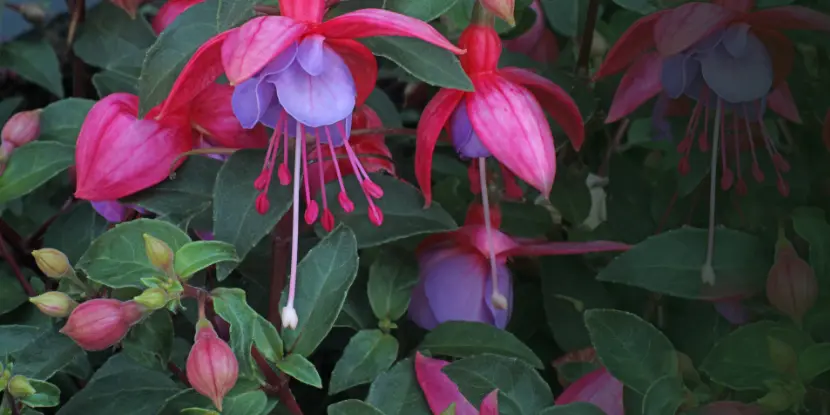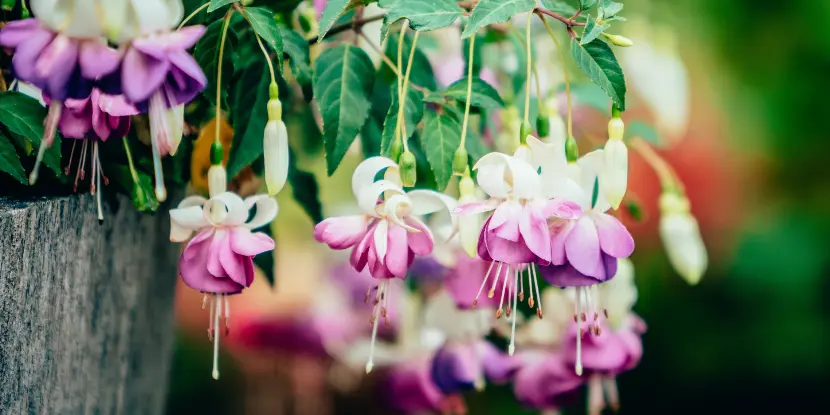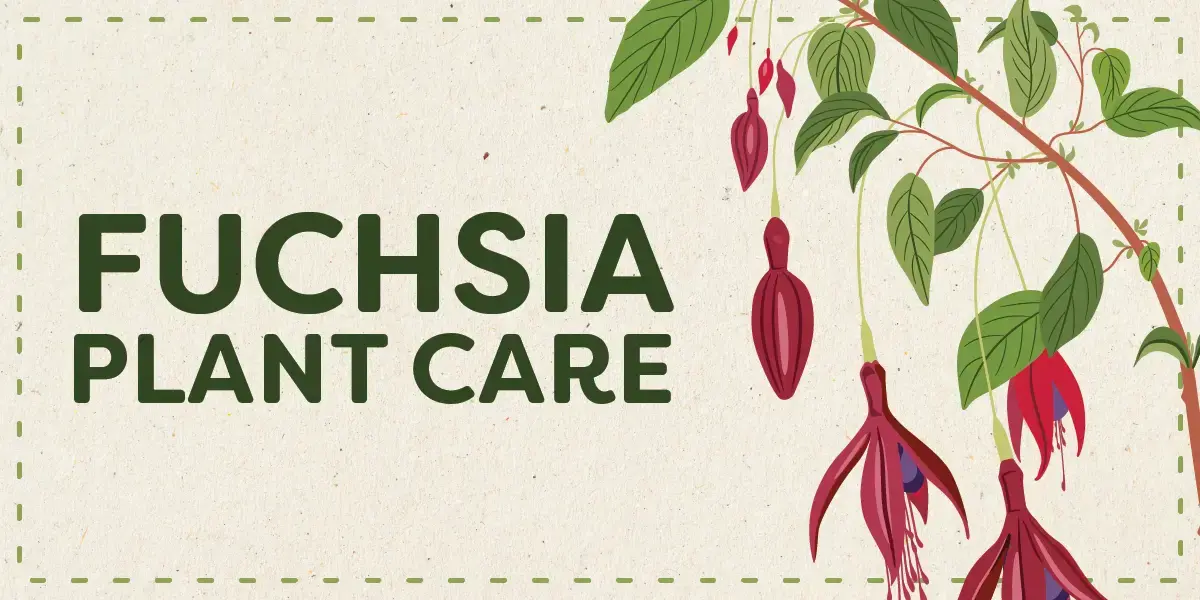“Fuchsia” may be hard to spell, but it’s easy to care for.
Of course, we’re talking about the spectacular flowering shrub that thrives in Southern California.
With just a little TLC, a fuchsia plant will reward you with bright, showy flowers from late spring to early fall.
Native to Central and South America, fuchsia prefers cool, moist summers and mild winters, growing like gangbusters along the California coast. Heat and drought-resistant varieties do well in California’s inland areas.
Choosing the Right Fuchsia Plant
Some good options for Southern California’s climate include:
- Fuchsia magellanica: Also known as “hardy fuchsia,” this hardy variety can withstand temperatures down to -10 degrees Fahrenheit. It produces small, red, and purple flowers throughout the summer.
- Fuchsia microphylla: More heat-tolerant than other varieties, this fuchsia blooms with bright pink and purple flowers from late spring to early fall.
- Fuchsia procumbens: With its trailing habit, this fuchsia is a natural for hanging baskets. Its brilliant yellow and green flowers have a touch of purple on the petals.
- Fuchsia boliviana: This variety with large, showy flowers can handle more sun than other fuchsias. Blooms range from orange-red to bright pink.
- Fuchsia splendens: Popular for its hardiness and long bloom time, it produces masses of red and purple flowers from late spring to early fall.
- Fuchsia “Santa Cruz”: This hybrid variety can handle heat and drought, making it an excellent choice for Southern California gardens. Its flowers are a stunning mix of orange-red and violet.
Select a well-established plant with plenty of foliage. Avoid plants with yellowing or spotted leaves, which could indicate pests or diseases.

Closeup of deep purple and hot pink fuchsia blooms.
Propagating Fuchsia from Cuttings
- Choose a healthy, non-flowering stem from your fuchsia plant. The cutting should be about 4 to 6 inches long.
- Use sharp, clean scissors or pruning shears to make a clean cut just below a leaf node (where a leaf attaches to the stem). Remove the leaves from the lower half of the cutting to expose the nodes.
- Dip the cut end of the stem into rooting hormone powder or gel. This step can encourage root growth.
- Fill a small pot with a well-draining potting mix, such as a mix formulated for seed starting or one part peat moss to one part perlite.
- Make a hole in the center of the potting mix with a pencil or your finger. Insert the cut end of the fuchsia into the hole, burying at least two nodes beneath the soil surface. Gently firm the soil around the cutting.
- Water the potting mix thoroughly. Cover the pot with a clear plastic bag or place it inside a propagator to create a humid environment for the cutting.
- Keep the pot in a warm location with bright, indirect light. Avoid direct sunlight.
- Check the potting mix regularly to ensure it remains moist. Watch for signs of growth. Roots should begin to form within 3-4 weeks.
- Once the cutting has established a root system, it can be transplanted into a larger pot or your garden.
Planting Fuchsia
Fuchsias can be planted year-round in Southern California, but the best time is spring after the last frost. Here’s how to get your fuchsia off to a good start:
- Find a spot with partial shade, especially during the hottest part of the day. Avoid areas with strong, direct sunlight, which can scorch the delicate foliage of fuchsia plants.
- Fuchsia plants prefer well-draining soil rich in organic matter with a pH range of 6.0 to 7.0. Amend the soil with compost or peat moss to improve drainage and fertility, and avoid planting in heavy clay soil.
- Dig a hole twice the size of the root ball and gently loosen the roots before placing the plant in the ground. Backfill with soil and water thoroughly.

Spectacular purple and pink fuchsia blossoms.
Watering & Fertilizing Fuchsia Plants
Watering
- Fuchsias require constant moisture but despise soggy roots.
- During the warmer months, water your plants deeply when the top inch of soil feels dry.
- Reduce watering in the cooler months to prevent root rot. A mulch layer can help maintain soil moisture and temperature.
Fertilizing
- Use a balanced, water-soluble fertilizer to promote healthy growth and flowering. An ideal fertilizer ratio for fuchsias is 20-20-20 (Nitrogen, Phosphorus, and Potassium).
- Fertilize every two to four weeks during the active growing season (spring and summer). Reduce the frequency to once a month in the fall. Don’t fertilize in winter when the plant’s growth naturally slows.
- Choose a fertilizer suitable for flowering plants, avoiding too much nitrogen, which can lead to lush foliage at the expense of blooms.

Delicate purple and hot pink fuchsia flowers.
Dealing with Pests & Diseases
Common issues affecting fuchsia include:
- Aphids: These small, sap-sucking insects distort new growth. Spray the plants with a jet of water to knock aphids off, or use neem oil or insecticidal soap as an organic treatment.
- Spider Mites: These tiny pests are hard to detect with the naked eye, but their webbing and the damage they cause to leaves are evident. Increase humidity around the plants and use a miticide made from essential oils. Introduce predatory mites to control them naturally.
- Whiteflies: Similar to aphids, whiteflies suck sap from the plants, leading to weakened growth. Yellow sticky traps can catch adults, and insecticidal soap can control larvae and young insects. Neem oil is also effective.
- Fuchsia Rust: This fungal disease causes orange to red spots on the undersides of leaves. Remove and destroy infected leaves to prevent the spread. Ensure good air circulation around the plants and water at the base to avoid wetting the foliage.
- Botrytis Blight (Grey Mold): This fungus affects flowers and leaves, especially in damp conditions. Improve air circulation and reduce humidity around the plants. Remove any infected parts promptly, and apply an organic fungicide if necessary.
- Fuchsia Gall Mite: A microscopic pest causing growth deformities. Prune the infected growth and dispose of it properly. You can apply Neem oil as a preventative measure, but extensive infestation may require plant removal to prevent disease spread.
Pruning Fuchsia Plants
Pruning is a crucial aspect of fuchsia plant health. Here’s what you need to know:
- Annual Pruning: Prune fuchsias every year, preferably in late winter or early spring before new growth begins. This timing stimulates flowering and maintains the plant’s shape.
- Promote Bushiness: Regular pruning encourages a bushier growth habit and more flowers. Pinch back young shoots to encourage branching and bushiness. Deadhead spent flowers to promote continuous blooming.
- Remove Dead or Diseased Wood: Always remove dead or diseased branches to prevent the spread of disease and keep the plant looking its best.
- Rejuvenation Pruning: If a fuchsia has become leggy or overgrown, cut back the plant to about 6 to 12 inches from the ground to encourage new growth.
- Thinning: Remove some older branches to improve air circulation through the plant. This helps prevent disease and allows light to reach the inner parts of the plant, promoting healthier growth.
- Use the Right Tools: Use sharp, clean pruning shears or scissors to make clean cuts and reduce damage to the plant.

White and lavender fuchsia flowers.
Protecting Fuchsia Plants from Extreme Weather
Protection from Heatwaves
- Mulching: Apply a thick layer of organic mulch, such as wood chips or straw, around the base of fuchsia plants to retain soil moisture and keep the roots cool.
- Shading: During extreme heat, provide temporary shade to your fuchsias by using a shade cloth or moving potted plants to a shaded area.
- Watering: Increase deep watering during heatwaves. Early morning or late evening watering is most effective.
Protection from Frosts
- Covering: When frost is forecast, cover your fuchsia plants with frost cloth or burlap to trap ground heat. The cover should extend to the soil level and be secured.
- Location: If possible, plant fuchsias in a location shielded from cold winds and frosts. Move potted fuchsias indoors or to a protected porch area during cold snaps.
- Mulching: A thick layer of mulch can insulate the soil and protect roots from freezing.
Container Cultivation
Growing fuchsias in containers lets you manage growing conditions and enjoy their beauty up close. Follow these steps for successful cultivation:
- Container: Select a container with drainage holes to prevent waterlogging. A 12 to 18-inch diameter pot is adequate for most fuchsia plants.
- Potting Mix: Use a high-quality, well-draining potting mix. Adding perlite or vermiculite can enhance drainage, an essential factor for fuchsia health.
- Positioning: Place the container where the fuchsia will receive morning sunlight and afternoon shade. Avoid direct afternoon sun, which can be too intense.
- Watering: Container-grown fuchsias may require more frequent watering than ground-planted ones, especially during hot weather. Check the soil’s moisture daily and water it once the top inch of soil feels dry.
- Fertilizing: Feed container-grown fuchsias with a balanced, water-soluble fertilizer every two weeks during the growing season. Reduce feeding in the fall and cease in the winter.
- Pruning and Pinching: Regularly pinch out the tips of young plants to encourage bushier growth. Implement annual pruning as needed to maintain shape and size.
- Overwintering: Move containers indoors or to a frost-free location during winter. Reduce watering and don’t fertilize during this period to allow the plant to rest.

A container-grown fuchsia plant in a wicker basket.
FAQs: Caring for Fuchsia Plants
Q: How long do fuchsia plants live?
In warm climates (USDA zones 10 and 11), fuchsias can live for several years with proper care, potentially up to 30 years. In colder climates, fuchsias are grown as annuals or container plants. They’ll flower throughout the summer and die with the frost.
Q: What is the USDA zone for Southern California?
Southern California falls within USDA zones 9 and 10. Zone 10 covers coastal areas, which benefit from the ocean’s moderating effect.
Q: Can fuchsias grow in full sun?
Fuchsias prefer partial shade or filtered sunlight. Direct afternoon sun can be too intense and may result in leaf burn and reduced flowering.
Q: Can fuchsias be grown from seed?
Yes, but it’s easier to propagate from cuttings or purchase established plants.
Q: When is the best time to prune fuchsia plants?
Prune fuchsia plants lightly throughout the growing season to remove dead or damaged branches and encourage bushy growth. Avoid heavy pruning in late fall or winter.
Q: Can fuchsia plants survive extreme heat in Southern California?
While fuchsia plants prefer mild temperatures and partial shade, they tolerate some heat with proper care. Provide shade during the hottest part of the day and ensure adequate moisture to help plants withstand high temperatures.
Q: Do fuchsias need a specific type of fertilizer?
Fuchsias thrive on a balanced, water-soluble fertilizer applied every two weeks during the growing season. Look for a fertilizer with an equal ratio of nitrogen, phosphorus, and potassium (e.g., 10-10-10).
Q: How can I encourage my fuchsia to bloom more?
Regularly deadhead spent flowers and pinch back the tips of stems to promote bushier growth. Ensuring adequate sunlight, water, and fertilizer also supports blooming.
Q: What is “deadheading” in horticulture?
Deadheading is the process of removing spent or faded flowers from a plant. It encourages new blooms and plant health. Deadheading also helps prevent seed formation, which can redirect energy away from flowering.
Q: How can I protect my fuchsias from wind damage?
Plant them in a sheltered area or use windbreaks like fences or dense shrubs. Move potted plants to a protected area during high winds.

